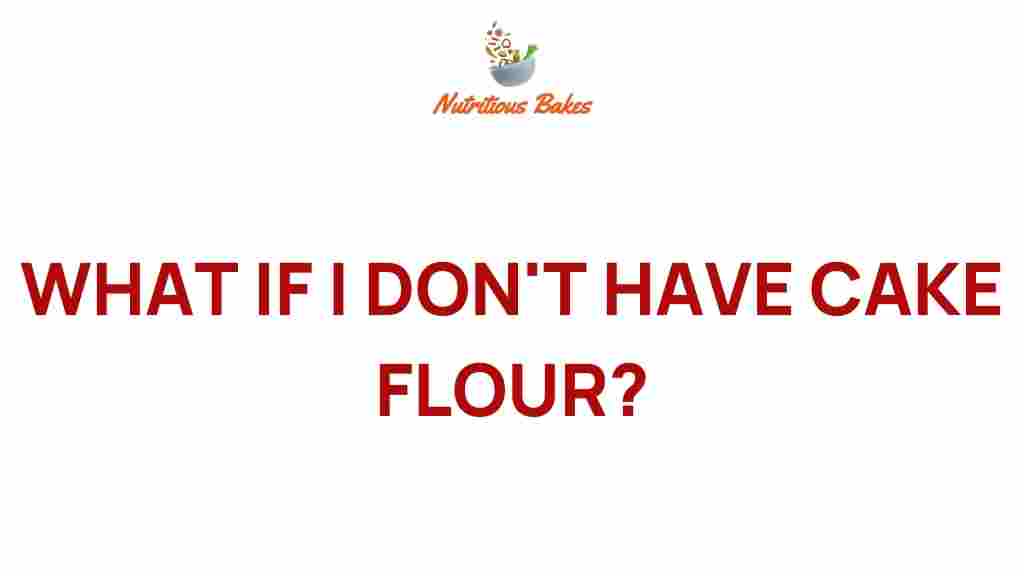The Cake Flour Conundrum: What to Do When You’re Out
Baking a cake can be a delightful experience, but what happens when you find yourself in the middle of a recipe and suddenly realize you’re out of cake flour? The cake flour conundrum can be a frustrating situation for any home baker. Cake flour is a finely milled flour with a low protein content, making it ideal for creating soft, tender cakes. However, there are numerous baking substitutes that can save the day. In this article, we will explore various options, including how to use all-purpose flour and pastry flour, along with helpful recipe tips and baking hacks that will make your baking endeavors successful even without cake flour.
Understanding Cake Flour
Cake flour is specially designed for baking cakes and other delicate pastries due to its low protein content, typically around 7-9%. This results in less gluten formation, which is key for achieving the light and fluffy texture desired in cakes. Understanding the characteristics of cake flour is crucial when looking for alternatives.
Using All-Purpose Flour as a Substitute
If you’re out of cake flour, one of the most common substitutes is all-purpose flour. However, because all-purpose flour has a higher protein content (10-12%), it can lead to denser cakes if used directly. Here’s how to modify it for better results:
- Measure and Sift: For every cup of cake flour needed, measure out one cup of all-purpose flour and remove two tablespoons.
- Add Cornstarch: Replace the two tablespoons of flour you removed with two tablespoons of cornstarch. This will lower the protein content and mimic cake flour more closely.
By using this method, you can significantly improve the texture of your cake, making it lighter and fluffier.
Pastry Flour: Another Great Alternative
If you happen to have pastry flour on hand, this can also serve as an excellent substitute for cake flour. Pastry flour has a protein content between 8-10%, making it a closer match to cake flour than all-purpose flour. Here’s how to use pastry flour:
- Direct Replacement: You can substitute pastry flour for cake flour in a 1:1 ratio, which means if your recipe calls for one cup of cake flour, you can use one cup of pastry flour instead.
Pastry flour will yield a tender crumb and is perfect for cakes, cookies, and pastries.
Flour Alternatives: More Options to Consider
Beyond all-purpose and pastry flour, there are other flour alternatives that can be utilized when you find yourself without cake flour:
- Self-Rising Flour: This flour already contains baking powder and salt. If you decide to use self-rising flour, reduce the amount of leavening agents in your recipe accordingly.
- Whole Wheat Flour: While it has a higher protein content, you can use it with a 50/50 mix of all-purpose flour for better results.
- Gluten-Free Flour Blends: If you need a gluten-free option, look for a gluten-free flour blend that is designed for baking. These blends often include a combination of rice flour, tapioca flour, and potato starch.
Recipe Tips for Using Substitutes
When substituting flour in your recipes, there are several recipe tips to ensure your cake turns out perfectly:
- Check the Consistency: The batter should have a similar consistency to what you expect when using cake flour. If it seems too thick or too runny, adjust by adding a little liquid or flour as needed.
- Monitor Baking Time: Cakes made with substitutes may bake faster or slower, so start checking for doneness a few minutes before the recipe suggests.
- Pay Attention to Texture: Keep in mind that using different flours can alter the texture of your cake. Always test a small batch if you’re unsure.
Baking Hacks for When You’re Out of Cake Flour
Here are some clever baking hacks to remember when you’re faced with the cake flour conundrum:
- Combine Flours: Mixing different types of flour can create a blend that works well for your recipe. Experiment with different ratios to find what works best.
- Use a Food Processor: If you’re using whole grains or coarser flours, using a food processor can help achieve a finer texture closer to cake flour.
- Store Properly: Ensure your flours are stored in a cool, dry place to maintain their freshness and quality.
Troubleshooting Common Issues
If you encounter problems while baking with substitutes, here are some troubleshooting tips:
- Dense Cake: If your cake turns out dense, it may be due to too much flour. Ensure accurate measuring and consider using a lighter flour.
- Dry Cake: A dry cake can occur if you’ve added too much cornstarch or flour. Try reducing the flour slightly or adding a bit more liquid.
- Crumbly Texture: If your cake crumbles too easily, it may not have enough fat or moisture. Consider adding an extra egg or a bit of oil to the batter.
Conclusion
The cake flour conundrum doesn’t have to ruin your baking plans. With a little knowledge about baking substitutes and some handy baking hacks, you can create delicious cakes even when you’re out of cake flour. Whether you opt for all-purpose flour, pastry flour, or other flour alternatives, remember to adjust your recipe accordingly. Always keep experimenting in the kitchen, and don’t hesitate to explore new combinations. Happy baking!
For more baking tips and tricks, check out our baking essentials. If you’re interested in learning about different types of flour, visit this external resource.
This article is in the category Tips and created by NutritiousBakes Team
